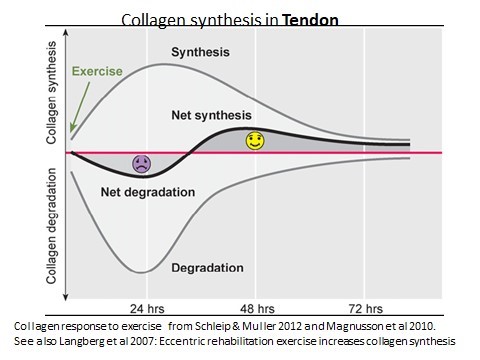Running makes us more resilient
Recently I reviewed the scientific literature on the best training programmes and preventing overuse injuries. Running is convenient, low cost and habit forming, and therefore it is getting more and more popular. Nowadays it’s not just for the sporty types, but for all: young and old, thin or fat, slow or fast. Last Saturday at 9am 148,000 people in Britain lined up, and finished a 5k parkrun. The enjoyment and health benefit are there for all to see in the parks and on social media.
Overuse injuries
The trouble with running is overuse injuries. Two out of three runners get an overuse injury every year. We need to look at the biochemical as well as the biomechanical reasons to prevent those injuries, as well as respond when we feel an injury. These chemical responses of our muscles to training are closely linked to the forces that we put on our bodies. Those forces are particularly dependent on our running speed. A good running style and the best footwear can reduce such forces.
All overuse running injuries could be classified as training errors [1,2]. Therefore all these injuries can be prevented with the right volume, duration, intensity and frequency of running. The person had too many times put high forces on a certain musculoskeletal structure. This too much is in relation to the resilience of these tissues.
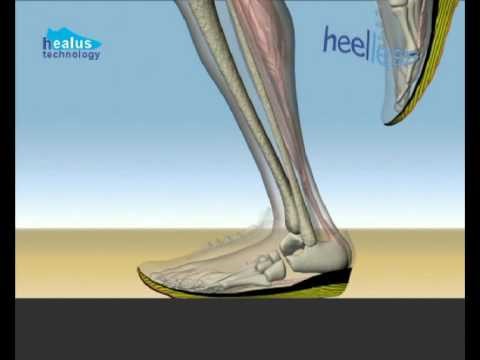
Resilience and running
For musculoskeletal tissue resilience means the ability of these body structures to absorb energy when it is deformed elastically, and to release that energy upon unloading. This is essential in running. Basically running is jumping on one leg, alternating between the left and the right. To keep the spring in our step and keep the momentum and therefore the speed, the calf muscles, the quads, the hamstrings and the gluteal muscles need to lengthen and spring back. Without this spring, we can hardly walk, never mind run.
The most elastic parts of the muscles are its tendons, and these need to withstand the high forces of distance running. Good training applies the right amount of stresses, as such that that resilience of tendon tissue increases, and the person gets fitter. This phenomenon is called “mechanotransduction” and brings about strengthening of the muscle’s connective tissue in response to loading regimes[3]. Loading the muscles through running means both eccentric (lengthening) and concentric (shortening) muscle contractions and frequent repetitions of such movements can be effective in making the muscles more resilient.
Supercompensation
Every runner needs to learn how not to overdo the running and not to train at too high an intensity, that results in breakdown of the musculoskeletal tissues. We need to learn how to plan our training as such that it results in tendon strengthening. The building of the muscles’ building blocks, the proteins, needs to be greater than the breakdown of these proteins. Training programmes reflect the planning of such work outs with the aim of achieving “super-compensation”. Super-compensation is the post training period during which the trained function has a higher performance capacity than it did prior to the training session. Timing of the sessions is important because of the time dependency of muscle protein breakdown and synthesis.
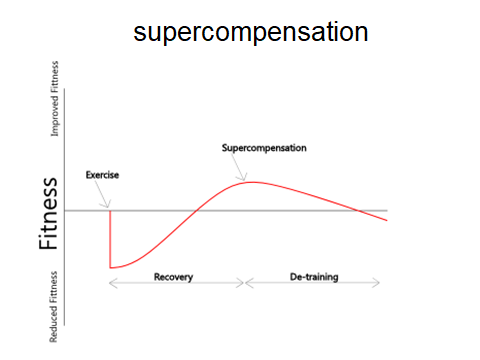
When the training programme is right, when the right volume, duration, intensity and frequency of running is right, all such injuries are prevented. The person recovers from the bout and achieves super-compensation: the runner is a little bit stronger days after the session.
Initially, during the exercise session, the muscles become fatigued, and as we can see from the second diagram, it depends on the type of session how long it takes for the muscle to recover and gain strength.
The muscles will end up becoming more and more resilient when we train at the right level, and time the sessions right. This intensity needs to be right and take place at the right time in relation to the previous training sessions.
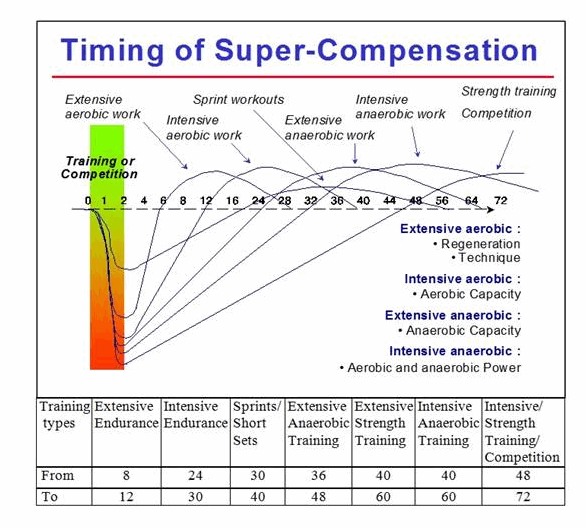
Building muscle
The experienced runner’s muscles are much more resilient, through all the running that he/she has done in the past. Therefore the advanced runner can run at a faster pace, and endure higher forces on their bodies.
My colleagues Philip Atherton and Ken Smith of the University of Nottingham reviewed the research on muscle protein synthesis: the building of muscle tissue, especially collagen. This work shows how the body adapts following bouts of training. It consistently revealed that exercises need to be at intensities greater than 60% of capacity to create any muscle protein synthesis. This muscle protein synthesis takes places in the hours after the exercises, after the training session and does not continue for longer than two days[4,5].
With untrained individuals, the intensity and volume needed to give net muscle synthesis is much lower than with trained athletes. It is much easier for the unfit and unexperienced runner to get better, to get a personal best. Running at 60% percent of one’s capacity or a bit faster is enough to get the benefit.
In a really high intensity running session, for example when we try to get a sharp personal best in a 5 kilometres parkrun, we work at more than 90% of our capacity. It will take most people more than 4 days to fully recover. It means that for 4 days the resilience in our tendons and muscles is actually less than before the hard parkrun. Provided we do not breakdown our muscle tissues any further: provided we take it easy in our running during those 4 days, the total building up of muscle and tendon will have been more than the breakdown of the connective tissue.
In the below diagram I have highlighted how we can get stronger and more resilient through this principle of loading and recovery over time. Such model of supercompensation guides the runner, and his / her coach, physiotherapist or personal trainer on the intensity levels of the various workouts during a standard micro-cycle of training: a week.
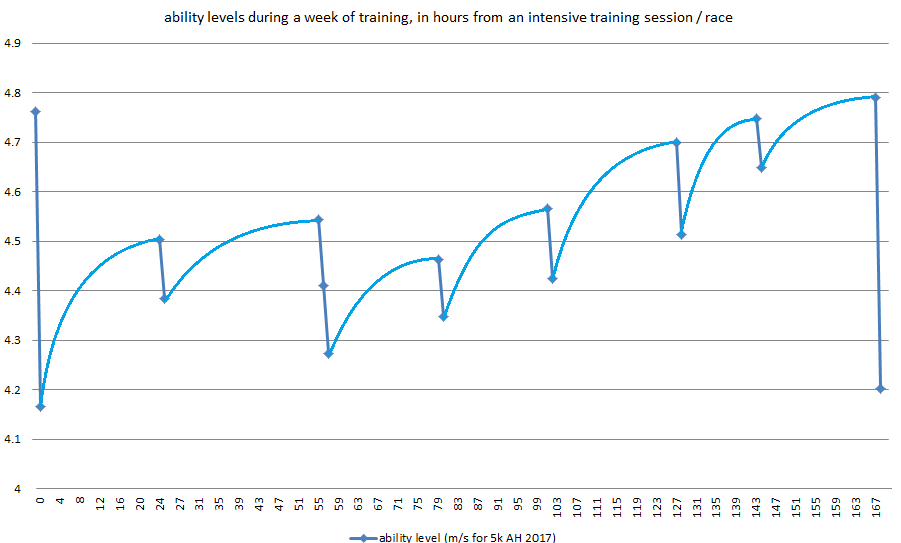
In this example of fluctuations of muscle endurance levels during a week of training there is a high intensity training session at the start of the week. During the run the resilience of the muscle reduces due to fatigue. In the remaining days of the week there are once daily medium and low intensity training sessions, and therefore the drop in the muscles’ ability is less. Only after 7 days the athlete achieves “super-compensation” and is ready to put in another high intensity training session.
A further more in-depth explanation can be found on fascinat.com.
Our training method “easy fartlek” is based on this research. Its outline, together with the scientific presentation “The role of lower intensity workouts in achieving net muscle protein synthesis (super-compensation)”, can be found on easyfartlek.com.
References
- Oestergaard Nielsen, R. et al (2012), “Training Errors and Running Related Injuries: a systematic review” Int J Sports Phys Ther., 7(1): 58–75.
- Hreljac, A. (2005) “Etiology, prevention, and early intervention of overuse injuries in runners: a biomechanical perspective” Phys Med Rehabil Clin N Am.16(3): 651-67.
- Kan, K.M. & Scott, A. (2009), “Mechanotherapy: how physical therapists’ prescription of exercise promotes tissue repair”, Br J Sports Med, 43, 247-251.
- Atherton, P.J. and Smith, K. (2012) “Muscle protein synthesis in response to nutrition and exercise” J Physiol., 590: 1049–1057.
- Damas et al (2015) “A Review of Resistance Training-Induced Changes in Skeletal Muscle Protein Synthesis and Their Contribution to Hypertrophy” Sports Med. 45, 801 –807.
This article was written by Adri Hartveld MSc MCSP and first published 8th June 2018.
If you would like to download a copy as a PDF then please CLICK HERE

